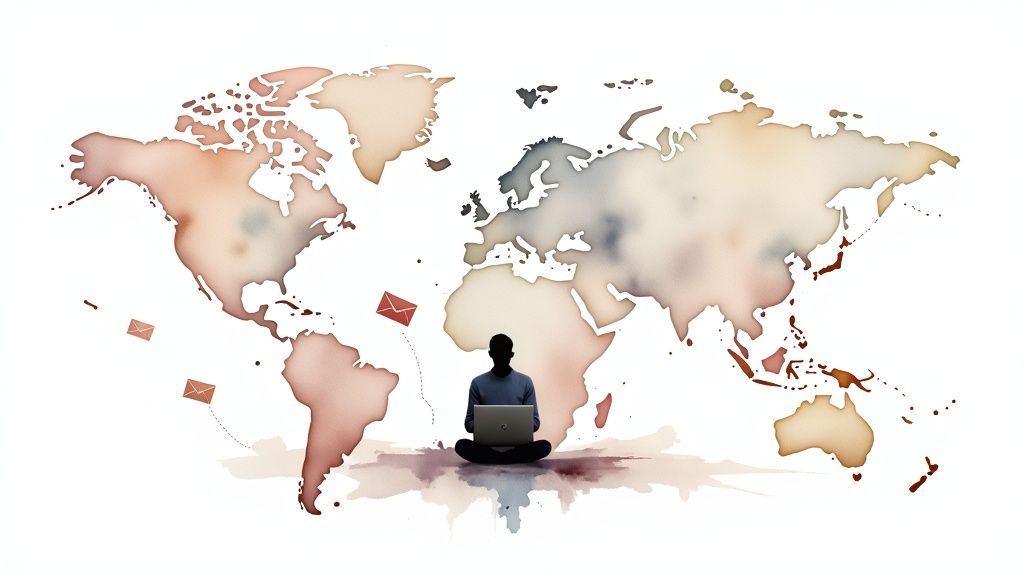Top 9 Best Skills for Remote Work in 2025
Max
The shift to remote work represents a fundamental change in how careers are built and managed. While the autonomy and flexibility are significant benefits, thriving in this environment demands a specific skill set that extends beyond traditional office competencies. Success is no longer just about your technical expertise; it’s about how effectively you can operate, communicate, and collaborate within a distributed team.
This guide moves beyond generic advice to provide a clear roadmap for mastering the core skills for remote work. We will detail the nine essential competencies that distinguish top-tier remote professionals. You’ll gain actionable strategies and practical insights to refine your abilities, whether you are actively seeking a new position or aiming to increase your impact in a current role. Developing these skills is not just about adapting; it’s about future-proofing your career and unlocking your full potential. For anyone navigating this professional evolution, understanding and honing these abilities is the critical first step toward sustained success and growth. This article will show you exactly how to do it, providing the practical steps needed to excel.
1. Digital Communication
In a remote setting, your ability to convey information, tone, and intent through digital channels is paramount. Digital communication isn’t just about typing; it’s the art of creating clarity and connection without physical presence. This encompasses everything from crafting concise emails and instant messages to engaging in productive video calls and contributing to shared documents. Without the nuances of in-person body language, mastering this is one of the best skills for remote work because it prevents misunderstandings, builds trust, and keeps projects moving forward efficiently.

Effective digital communication is the foundation of successful remote-first companies. For example, GitLab operates a fully remote workforce by prioritizing comprehensive documentation, ensuring every team member has access to the same information asynchronously. Similarly, Slack’s internal culture, championed by Stewart Butterfield, emphasizes transparent and channel-based communication to reduce siloed conversations and keep everyone aligned.
How to Improve Your Digital Communication
To elevate your communication, focus on clarity, context, and connection. Start by being deliberate in your choice of communication tool. Is the message urgent, or can it wait for an email? Does it require a nuanced discussion best suited for a video call?
Here are actionable tips to implement immediately:
- Be Explicit with Tone: Written text lacks emotional cues. Use emojis or tone indicators like “(just brainstorming!)” to add context and prevent misinterpretation, especially in rapid-fire chat platforms.
- Structure for Skimmability: In emails and documents, use clear subject lines, bold text for key takeaways, and bullet points or numbered lists. This helps your colleagues quickly grasp the most important information.
- Practice Active Listening on Calls: During video meetings, eliminate distractions, nod, and provide verbal affirmations like “I understand” or “That makes sense.” Summarize key points to confirm you’ve understood correctly before moving on.
- Establish Team Protocols: Work with your team to create clear guidelines. Define expectations for response times on different channels and establish a process for escalating urgent issues.
2. Time Management and Self-Discipline
Without a manager physically present, your ability to organize, prioritize, and execute tasks independently becomes critical. Time management and self-discipline are the twin engines that drive productivity in a remote setting. This skill involves structuring your day, battling distractions, and maintaining momentum without external oversight. Mastering this is one of the best skills for remote work because it ensures you meet deadlines, produce high-quality work, and maintain a healthy work-life balance, preventing burnout.

This skill is the cornerstone of many successful remote workers’ routines. Author Cal Newport’s “Deep Work” methodology, which champions long, uninterrupted periods of focus, has been widely adopted to combat the constant distractions of a home environment. Similarly, David Allen’s “Getting Things Done” (GTD) system provides a framework for capturing and organizing tasks, allowing remote professionals to stay on top of complex projects without feeling overwhelmed. These systems provide the structure that is often missing from an unstructured remote workday.
How to Improve Your Time Management and Self-Discipline
To improve, focus on creating structure and intention in your workday. Start by establishing a clear routine that signals to your brain when it’s time to work and when it’s time to rest. To effectively manage your workload and meet deadlines in a remote environment, utilizing appropriate tools is crucial. You can explore a range of effective time management tools to find what works best for your workflow.
Here are actionable tips to implement immediately:
- Create a Dedicated Workspace: Designate a specific area for work only. This physical boundary helps create a psychological separation between your professional and personal life.
- Use Time-Blocking: Schedule your entire day in blocks, assigning specific tasks to each period. This includes scheduling focused work, meetings, and even breaks, which helps protect your time and energy.
- Set Clear Boundaries: Establish a firm start and end time for your workday. Communicate these hours to your team and stick to them to avoid overworking and maintain balance.
- Practice the Pomodoro Technique: Work in focused 25-minute intervals followed by a 5-minute break. This method helps maintain high concentration levels and prevents mental fatigue throughout the day.
3. Technology Proficiency
In a remote environment, your toolkit is entirely digital. Technology proficiency goes beyond knowing how to use one or two apps; it’s the ability to quickly adapt to, master, and troubleshoot the diverse software that enables remote collaboration. This includes everything from cloud storage and project management platforms to communication hubs and security protocols. Developing a strong technical aptitude is one of the best skills for remote work as it ensures you can operate self-sufficiently, maintain productivity, and integrate seamlessly into a distributed team’s digital ecosystem.

Remote-first pioneers exemplify this skill. For instance, Automattic’s globally distributed team thrives by proficiently using a wide array of digital tools to collaborate across time zones. Similarly, Zapier leverages its own automation product to connect various apps and streamline workflows, requiring employees to be adept at managing complex, integrated software environments. These companies prove that deep tech literacy is the backbone of efficient remote operations.
How to Improve Your Technology Proficiency
To enhance your technical skills, focus on both foundational knowledge and a willingness to learn new platforms. Start by identifying the core tools used in your industry and dedicating time to understanding their advanced features, not just the basics. A great first step is to explore the 12 essential tools for remote teams.
Here are actionable tips to implement immediately:
- Learn Basic Troubleshooting: Don’t wait for IT. Learn how to solve common issues like clearing your cache, checking network connections, or reinstalling an application. This autonomy is highly valued in remote settings.
- Master Keyboard Shortcuts: For the applications you use daily, learn the key keyboard shortcuts. This small habit can dramatically increase your speed and efficiency, saving valuable time throughout your day.
- Prioritize Digital Security: Use a password manager to create and store strong, unique passwords for every service. Enable two-factor authentication (2FA) wherever possible to protect company and personal data.
- Stay Current with Industry Tools: The tech landscape changes quickly. Follow industry blogs, watch tutorials, or take short online courses to stay informed about the latest software and platforms relevant to your role.
4. Adaptability and Problem-Solving
Remote work is dynamic and often unpredictable; your manager isn’t a few steps away to answer every question. The ability to pivot quickly, independently troubleshoot issues, and remain productive amidst uncertainty is crucial. This skill involves resourcefulness, creative thinking, and a willingness to learn on the fly. Mastering adaptability and problem-solving is one of the best skills for remote work because it demonstrates self-reliance and resilience, proving you can deliver results without constant supervision.

The rapid, global shift to remote work during the COVID-19 pandemic is a testament to this skill’s importance. Companies that thrived, like Shopify which moved to a permanent remote model, did so because their teams could adapt their processes and solve novel challenges swiftly. This principle, popularized by agile methodologies and Carol Dweck’s “Growth Mindset” research, is about treating obstacles as opportunities for learning and innovation rather than as dead ends.
How to Improve Your Adaptability and Problem-Solving
To become more adaptable, you must proactively cultivate a mindset that embraces change and seeks solutions. Instead of waiting for direction when you hit a roadblock, take the initiative to explore potential fixes first. This builds confidence and makes you a more valuable team member.
Here are actionable tips to implement immediately:
- Embrace a Growth Mindset: View challenges as learning opportunities, not as reflections of your fixed abilities. Ask yourself, “What can I learn from this?” instead of “Why can’t I do this?”
- Document Your Solutions: When you solve a tricky problem, write down the steps you took. This creates a personal knowledge base and can be shared to help your team members overcome similar issues in the future.
- Build a Support Network: Cultivate relationships with colleagues and peers in your industry. When you’re stuck, this network becomes a valuable resource for advice, different perspectives, and collaborative brainstorming.
- Practice Scenario Planning: For important projects, think through potential obstacles. Ask “what if” questions and develop a few backup plans (Plan B, Plan C) so you’re prepared to pivot without losing momentum.
5. Collaboration and Teamwork
In a distributed environment, teamwork isn’t about sharing an office; it’s about sharing a purpose and working cohesively across different locations, time zones, and cultures. Remote collaboration is the skill of using digital tools to build trust, maintain momentum, and achieve collective goals without physical proximity. This involves proactive communication, mutual respect, and a shared commitment to the team’s success. Mastering virtual teamwork is one of the best skills for remote work because it transforms a group of individuals into a high-performing, unified force.
This skill is the engine behind many successful remote-first companies. For instance, GitHub’s entire platform is built around distributed collaboration, using pull requests to review and merge code asynchronously. Similarly, creative teams at companies like Figma use real-time collaborative design tools to brainstorm and build products together, proving that innovation can thrive without a shared physical whiteboard. These examples show that the right mindset and tools can make remote teamwork incredibly effective.
How to Improve Your Collaboration and Teamwork
To become a better remote collaborator, focus on reliability, visibility, and empathy. Your goal is to be a dependable and proactive team player who contributes positively to the virtual team dynamic, even when facing challenges or disagreements. Learn more about navigating team conflicts remotely to build stronger relationships.
Here are actionable tips to implement immediately:
- Be Proactively Visible: Don’t wait to be asked for an update. Share your progress regularly in shared channels, comment constructively on others’ work, and make your contributions visible to the team.
- Practice Cultural Sensitivity: When working with a global team, be mindful of different communication styles, holidays, and working hours. Acknowledge and respect these differences to foster an inclusive environment.
- Celebrate Team Wins: Actively acknowledge and celebrate the achievements of your colleagues in public channels. This builds morale, reinforces a positive culture, and helps team members feel valued and connected.
- Be Responsive and Reliable: Answer messages in a timely manner and consistently deliver on your commitments. In a remote setting, your reliability is a direct measure of your trustworthiness and respect for your team’s time.
6. Emotional Intelligence and Self-Awareness
When you lose the casual, in-person interactions of an office, the ability to understand and manage your own emotions while recognizing those of others becomes critical. Emotional intelligence and self-awareness involve managing stress, practicing empathy, and maintaining your mental well-being in an isolated environment. Cultivating this is one of the best skills for remote work because it helps build psychological safety, fosters stronger team connections, and prevents burnout when professional and personal boundaries blur.
Pioneering remote companies understand this connection well. Buffer, for example, has long focused on team well-being and transparent conversations around mental health. Similarly, many remote-first organizations now offer resources like Headspace subscriptions or designated mental health days, recognizing that a supported team is a productive team. This shift, championed by thought leaders like Brené Brown, highlights how empathetic leadership is essential for remote success.
How to Improve Your Emotional Intelligence and Self-Awareness
To boost your emotional intelligence, focus on introspection, empathy, and proactive well-being. Start by acknowledging the unique stressors of remote work, such as digital fatigue and social isolation, and create intentional habits to counteract them.
Here are actionable tips to implement immediately:
- Practice Regular Self-Reflection: Set aside a few minutes each day to check in with yourself. Journal about your feelings, identify stress triggers, and acknowledge your emotional state without judgment.
- Schedule Informal Check-ins: Intentionally create space for non-work-related conversations with colleagues. A virtual coffee chat can help you connect on a human level and better read the emotional pulse of your team.
- Use Video to Read Cues: Whenever possible, opt for video calls for sensitive or complex discussions. Seeing facial expressions and body language provides crucial emotional context that is lost in text.
- Develop Coping Strategies: Identify healthy ways to manage stress, whether it’s taking a walk, practicing mindfulness, or setting a firm boundary at the end of the workday. Communicate these needs to your team when appropriate.
7. Project Management and Organization
When you’re not in a shared office, the ability to independently manage your work and align with team objectives becomes critical. Project management and organization is the skill of planning, executing, and tracking projects from start to finish. This involves managing timelines, allocating resources, assessing risks, and coordinating with a distributed team, all while maintaining complete visibility for stakeholders. Mastering this is one of the best skills for remote work as it ensures autonomy doesn’t lead to chaos, keeping everyone productive and focused on shared goals.
This skill is the backbone of successful distributed companies. For instance, Basecamp, co-founded by Jason Fried, built its entire product around a project-centric approach that fosters asynchronous collaboration and clear ownership. Similarly, Atlassian champions distributed Agile methodologies, enabling its remote teams to iterate quickly and manage complex software development projects with tools like Jira and Trello, proving that physical proximity isn’t a prerequisite for high-level execution.
How to Improve Your Project Management and Organization
To strengthen your organizational skills, focus on creating structure, promoting transparency, and anticipating challenges. This starts with choosing the right tools and establishing clear processes that the entire remote team can follow, ensuring no one is left guessing about their responsibilities or project status.
Here are actionable tips to implement immediately:
- Use Visual Project Management Tools: Platforms like Trello, Asana, or Monday.com provide a visual “single source of truth.” Use Kanban boards or Gantt charts to make project progress, deadlines, and dependencies clear at a glance.
- Set Clear Milestones and Deadlines: Break down large projects into smaller, manageable tasks with distinct deadlines. This creates momentum and allows for easier progress tracking and accountability across different time zones.
- Communicate Progress Proactively: Don’t wait to be asked for an update. Provide regular, concise status reports in a designated channel or document. This builds trust and reduces the need for constant check-in meetings.
- Build in Buffers for Remote Delays: Remote work can have unique delays, such as time zone differences or home-life interruptions. Plan for this by adding a small buffer to your project timelines to absorb unexpected issues without derailing the entire project.
8. Written Communication Skills
In a remote-first world, your writing is your voice, your handshake, and your reputation all in one. Written communication is the art of conveying complex ideas with clarity, precision, and the appropriate tone through text. It’s the lifeblood of asynchronous work, enabling teams to stay aligned across time zones through well-crafted emails, detailed project documentation, and insightful instant messages. Mastering written communication is one of the best skills for remote work because it eliminates ambiguity, creates a single source of truth, and empowers team members to contribute effectively without constant real-time meetings.
This skill is a cornerstone of highly successful remote organizations. Amazon, under Jeff Bezos, famously replaced PowerPoint presentations with six-page narrative memos to foster deep thinking and clear communication. Similarly, GitLab’s extensive public handbook is a testament to their documentation-first culture, where writing is the primary method for collaboration, onboarding, and knowledge sharing. This approach ensures every decision and process is transparent and accessible.
How to Improve Your Written Communication
To enhance your writing, prioritize clarity over complexity and empathy over ego. Always consider your audience and the context of your message. Cultivating professional letter writing skills is essential for clear and effective communication in a remote setting, ensuring your messages are always received as intended.
Here are actionable tips to implement immediately:
- Write for the Reader: Before you type, ask yourself: “What does my audience need to know?” and “What action do they need to take?” Structure your writing to answer these questions upfront.
- Use Active Voice and Simple Language: Avoid passive constructions and jargon. Active voice (e.g., “Our team will complete the project”) is more direct and easier to understand than passive voice (“The project will be completed by our team”).
- Structure for Clarity: Employ clear headings, bold text for key points, and bulleted lists to make your writing scannable. This respects your colleagues’ time and improves comprehension.
- Provide Context and Next Steps: Never assume the reader has the full background. Briefly state the context and clearly outline what needs to happen next, including deadlines and owners. If you want to dive deeper into crafting messages that get results, learn more about how to write effective emails.
9. Digital Security and Privacy Awareness
When your office is a network of homes, coffee shops, and co-working spaces, the perimeter of company security dissolves. Digital security and privacy awareness is the critical practice of protecting sensitive personal and company data from cyber threats in a distributed environment. This involves everything from using secure Wi-Fi and strong passwords to recognizing phishing attempts and understanding data encryption. In an era where a single breach can be catastrophic, this is one of the best skills for remote work because it transforms every employee into a first line of defense, safeguarding assets, reputation, and client trust.
The shift to remote work has accelerated the adoption of advanced security protocols. For instance, many tech companies now operate on a zero-trust security model, which assumes no user or device is inherently trustworthy and requires verification for every access request. Cybersecurity training, championed by organizations like the SANS Institute, is now standard for remote teams to combat sophisticated social engineering attacks. Likewise, the rise of password managers like 1Password and LastPass highlights the growing individual responsibility for maintaining digital hygiene.
How to Improve Your Digital Security and Privacy Awareness
Building strong security habits is about creating layers of protection. Start by assessing your current practices and identifying weak points, such as password reuse or connecting to unsecured public networks without protection. A proactive and vigilant mindset is your most valuable asset.
Here are actionable tips to implement immediately:
- Master Password Management: Use a password manager to generate and store unique, complex passwords for every account. This eliminates the risk of a single compromised password exposing multiple systems.
- Enable Two-Factor Authentication (2FA): Activate 2FA on all critical accounts, including email, banking, and company software. This adds a crucial security layer that protects you even if your password is stolen.
- Use a VPN on Public Networks: When working from a cafe or airport, always use a Virtual Private Network (VPN). A VPN encrypts your internet traffic, making it unreadable to anyone snooping on the network.
- Keep Everything Updated: Regularly update your operating system, browser, and all applications. These updates often contain critical patches for newly discovered security vulnerabilities. For a deeper understanding, explore our guide to remote cyber security.
Top 9 Remote Work Skills Comparison
| Skill/Aspect | Implementation Complexity 🔄 | Resource Requirements ⚡ | Expected Outcomes 📊 | Ideal Use Cases 💡 | Key Advantages ⭐ |
|---|---|---|---|---|---|
| Digital Communication | Moderate - mastering multiple channels & etiquette | Moderate - tools like Slack, Zoom, Teams needed | Clear global communication, documented trails | Remote teams, global collaboration | Enables cross-timezone clarity, thoughtful responses |
| Time Management and Self-Discipline | Moderate - requires habitual focus and routines | Low - mostly personal effort and productivity tools | Increased productivity and work-life balance | Independent remote workers, freelancers | Boosts efficiency, autonomy, and stress reduction |
| Technology Proficiency | High - continuous learning and troubleshooting | High - diverse software/tools & security setups | Seamless collaboration, reduced IT dependency | Tech-heavy remote roles, distributed teams | Enables efficiency and global work opportunities |
| Adaptability and Problem-Solving | Moderate to High - mental flexibility & creativity | Low to Moderate - mindset and supportive networks | Thrives in change, skill growth, independent solutions | Dynamic environments, startups, freelancers | Increases resilience and reduces dependency |
| Collaboration and Teamwork | Moderate - managing virtual dynamics and culture | Moderate - collaboration platforms and synchronous/asynchronous coordination | Global teamwork, cross-cultural inclusion | Distributed teams, cross-functional projects | Access to diverse talent and documented collaboration |
| Emotional Intelligence and Self-Awareness | Moderate - ongoing self and social skills development | Low - time investment in reflection and communication | Better remote relationships and morale | Remote managers, isolated workers | Enhances empathy, conflict resolution, and well-being |
| Project Management and Organization | High - applying methodologies and coordinating resources | Moderate to High - PM tools and process adherence | Higher project success with clear accountability | Remote project leads, agencies, open source teams | Improves coordination, resource use, and reporting |
| Written Communication Skills | Moderate - clear, concise, audience-focused writing | Low - writing tools and training | Reduced misunderstandings, permanent communication | Documentation-heavy roles, async communication | Scales communication and improves clarity |
| Digital Security and Privacy Awareness | Moderate - requires continuous learning and vigilance | Moderate - security tools and protocols | Protected data, reduced cyber risks | Remote employees handling sensitive information | Builds trust and ensures regulatory compliance |
Building Your Future: From Skills to Success
Navigating the landscape of remote work successfully is no longer about simply having an internet connection and a laptop. As we’ve explored, thriving in a distributed environment is a deliberate practice built upon a foundation of specific, interconnected skills. Moving beyond the basics of showing up online, true remote success is achieved by mastering the nuances of digital communication, cultivating unwavering self-discipline, and embracing technological fluency.
The journey from a competent remote employee to an indispensable team member is paved with these nine core competencies. From the clarity of your written communication to your proactive approach to digital security, each skill builds upon the others. Effective time management makes you a reliable collaborator, while high emotional intelligence strengthens your digital communication, ensuring your intentions are understood and your relationships with colleagues are strong, regardless of physical distance.
From Knowledge to Action: Your Next Steps
Merely understanding the best skills for remote work is only the first step; the real transformation begins with intentional application. Don’t feel pressured to master all nine areas at once. Instead, adopt a strategic approach to your professional development:
- Conduct a Self-Audit: Honestly assess your current capabilities against the skills listed. Where do you excel? Which areas present the most significant opportunity for growth? Perhaps your project management is solid, but your asynchronous communication could be more concise.
- Choose Your Focus: Select one or two skills to prioritize for the next quarter. For instance, you might decide to focus on enhancing your adaptability by volunteering for a new type of project or strengthening your tech proficiency by learning a new collaboration tool like Asana or Miro.
- Implement and Iterate: Apply the specific, actionable tips shared throughout this article. Set small, measurable goals. Track your progress, seek feedback from your manager or peers, and adjust your strategy as you learn. Continuous improvement is the goal, not overnight perfection.
Mastering these skills is more than just a box-ticking exercise for your resume; it’s about future-proofing your career. Companies are actively seeking professionals who can operate with autonomy, collaborate seamlessly across time zones, and contribute meaningfully to a virtual culture. By investing in these areas, you are not just improving your performance, you are increasing your marketability, your professional resilience, and your capacity for a fulfilling, location-independent career.
Ready to put your newly honed skills to the test? The best way to validate your expertise is to find a role that demands and rewards it. Explore the curated, spam-free listings on Remote First Jobs to connect with forward-thinking companies actively seeking professionals who possess the very skills needed to excel in a distributed world.


